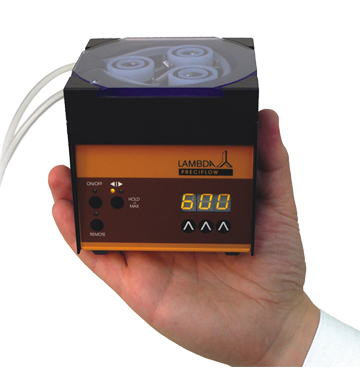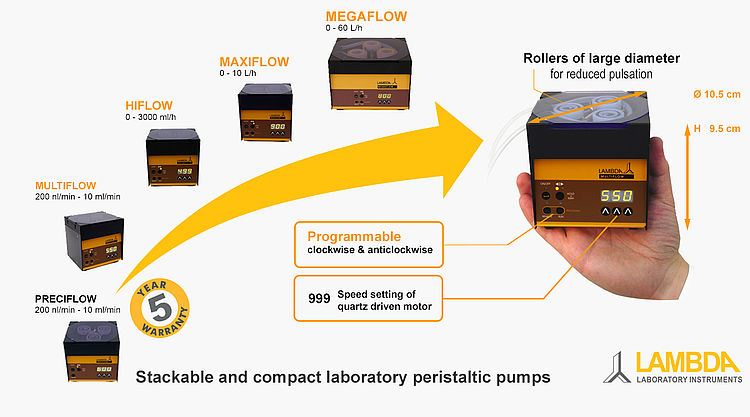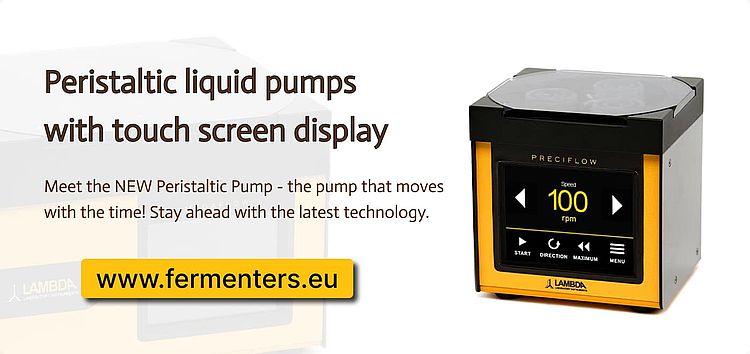Schlauchpumpen für das Labor
Schlauchpumpen für das Labor
LAMBDA Schlauchpumpen sind praktisch, präzis und die kompaktesten ihrer Klasse. LAMBDA PRECIFLOW, MULTIFLOW, HiFLOW, MAXIFLOW & MEGAFLOW sind speziell für Langzeiteinsätze im Labor konstruiert.
LAMBDA Schlauchpumpen für das Labor sind leicht, handgross und somit um ein Mehrfaches kleiner. Zudem sind LAMBDA Schlauchpumpen stapelbar und sparen teure Laborfläche.
Eigenschaften der LAMBDA Schlauchpumpen
Die ausgezeichnete Pumpenmechanik der LAMBDA Schlauchpumpen führt zu folgenden Eigenschaften:
- Durchsatz 0.01 ml/h – 60 L/h
mit digitaler Drehzahlregelung - Äusserst kompakt, leicht und flüsterleise
- Minimierte Pulsierung
- Langlebig und sehr ökonomisch unter Verwendung von kostengünstigen Silikonschläuchen
- ohne Reiter (Stopper)
- 5 Jahre Garantie auf LAMBDA PRECIFLOW & MULTIFLOW
- Wartungsarm
- Batteriebetrieb für Feldversuche möglich
- Erfüllt Sicherheitsnormen CE und IEC 1010/1 für das Labor
Eigenständiges Laborgerät:
- Digitale Drehzahl-Einstellung 0 bis 999 (in beiden Richtungen)
- Programmierbar in beide Pumprichtungen: MULTIFLOW, HiFLOW, MAXIFLOW, MEGAFLOW
- Stecker-Netzgerät: 90–240 V/AC, 50–60 Hz, Ausgang 12 V/DC
Peripheriegerät für Laborfermenter, Bioreaktoren, Autosampler und andere Laborgeräte
Fernsteuerung (analog und digital)
- Ein/Aus
- Progressiv über den gesamten Geschwindigkeitsbereich (0 – 10 V)
LAMBDA Schlauchpumpen sind auch an ihr PLS (Prozessleitsystem) oder an einen PC / Laptop anschliessbar.
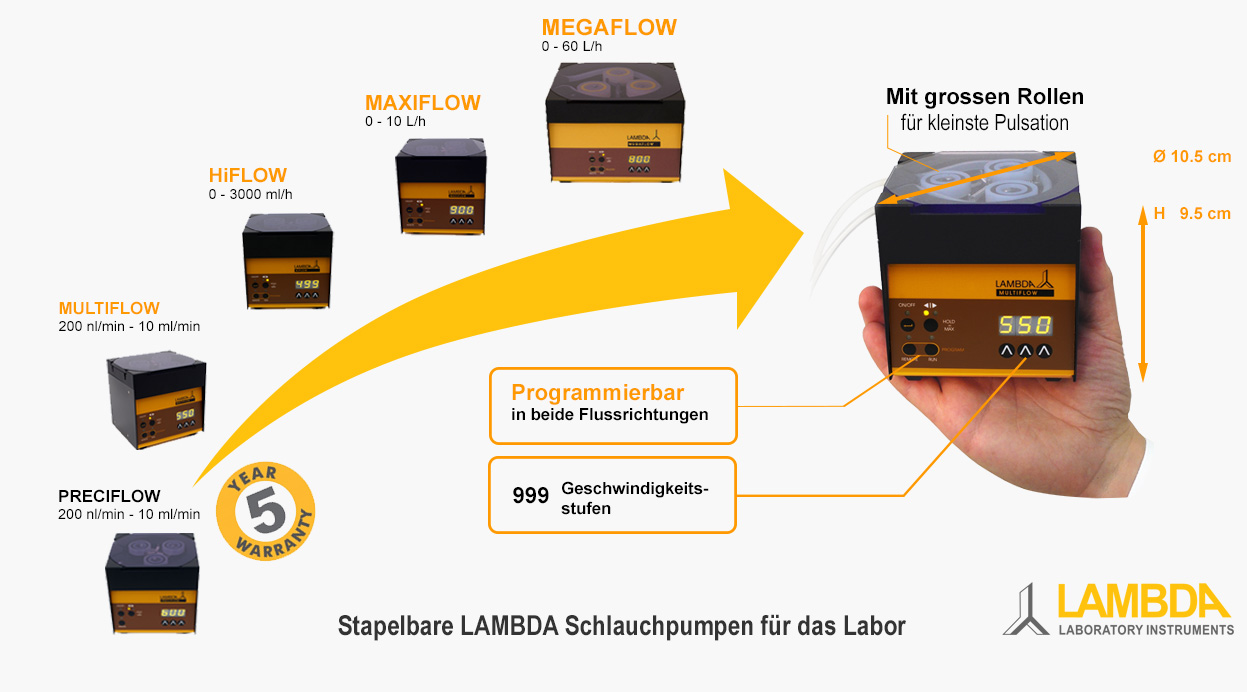
Besondere Merkmale der LAMBDA Schlauchpumpen
Die besonderen Merkmale der LAMBDA Schlauchpumpen sind wichtig für die Minimierung der Pulsation und für genaue Langzeiteinsätze mit anhaltender Präzision:
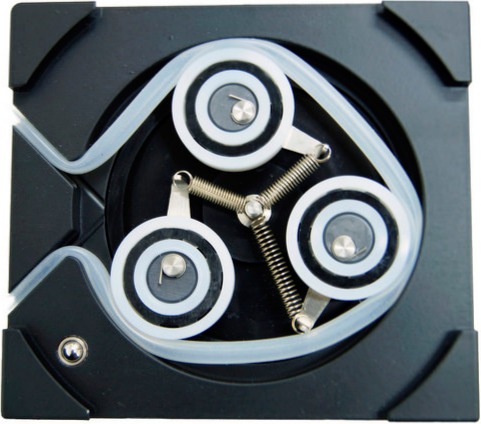 |
|
Sicherheit
- Erfüllt Sicherheitsnormen CE und IEC 1010/1
- Maximale Sicherheit durch Stromversorgung mit Niederspannung
(Stecker-Netzgerät: 90–240 V/AC, 50–60 Hz, Ausgang 12 V/DC) - Robuste Konstruktion mit Lösungsmittelbeständiger Aussenbeschichtung
Optionaler Zubehör
LAMBDA liefert folgenden Zubehör für Schlauchpumpen (Optionen):
- Silikonschläuche, Vitonschläuche
- Fussschalter (Pedal) für wiederholte Dosierungen
- Kabel zum Anschluss an Autobatterie (für Feldversuche)
- LAMBDA INTEGRATOR zur Erfassung des gepumpten Volumens
Der Durchfluss-Integrator LAMBDA INTEGRATOR liefert zusammen mit den LAMBDA Peristaltikpumpen wertvolle Informationen im Einsatz in automatisch kontrollierten Systemen wie der Fermentation, Zellkulturen, der chemischen Synthese, Fraktionssammlung und vielen mehr.
Die LAMBDA Peristaltikpumpen bieten auch mehrere Möglichkeiten zur Fernsteuerung:
- RS-485 oder RS-232 Schnittstelle (optional) für die Fernsteuerung
- Kabel und Anschlüsse für die Fernsteuerung (analog, digital)
- Pumpensteuerungs-Software PNet zur Datenerfassung, real-time Visualisierung und Fernsteuerung
Anwendungen der Schlauchpumpen im Labor
LAMBDA Schlauchpumpen kommen im Labor in der Fermentation, Biotransformation, technischen Mikrobiologie und in der Aufarbeitung zum Einsatz
- Säure- und Basepumpen in der Fermentation (Bioreaktor, pH-Stat)
- Fütterungspumpe / Aberntepumpe für kontinuierliche Zellkulturen
- Auftragen der flüssigen Phase in der Säulenchromatographie
- Laborpumpe für Filtrationen im DSP (Down Stream Processing)
- Dosierpumpen für Agar und Medium in der Versuchsvorbereitung
- Pumpe für Autosampler
Die Probleme herkömmlicher Schlauchpumpen sind gelöst!
Die häufigsten Probleme herkömmlicher Schlauchpumpen sind:
- Einzug des Schlauchs in Förderrichtung
Rollen mit kleinem Durchmesser setzen den Schlauch einer hohen Belastung aus und drücken ihn in Rotationsrichtung. Darum benötigen herkömmliche Schlauchpumpen oft spezielle Schläuche mit Stopper.
- Abnutzung der Schlauchwand bis zur Leckage
- Abnahme des Durchflusses beim Einsatz über mehrere Wochen
- Massiver Geld- und Zeitverlust durch eine Pumpenstörung bei Langzeitversuchen
LAMBDA Schlauchpumpen hat genau diese Probleme gelöst:
Was macht die neue Schlauchpumpe von LAMBDA so effizient?
Die ausgeklügelte Mechanik macht LAMBDA Schlauchpumpen derart effizient:
Rollen für eine niedrige Schlauchbeanspruchung und minimierte Pulasation
LAMBDA Schlauchpumpen fördern mit Rollen von grossem Durchmesser – damit wird die hohe Beanspruchung des Schlauchs eliminiert: Der Schlauch bewegt sich nicht in Förderrichtung und seine Elastizität bleibt erhalten.
Anstelle herkömmlicher Rollen setzt LAMBDA spezialgefertigte Plastikkugellager mit Glaskügelchen in den Pumpenkopf ein. Das Gleiten der korrosionsbeständigen Rollen benötigt nur eine minimale Kraft.
Ein exzentrischer Hebel und eine Feder aus korrosionsbeständigem Material komprimieren den Schlauch kontinuierlich und sanft.
Der resultierende Flüssigkeitsdruck liegt zwischen 0.1 und 0.2 MPa (je nach Schlauchbeschaffenheit). Der Druck steigt auch bei blockierter Linie nicht an.
Der grosse Pumpenkopf aus hartem, chemisch beständigem Material besitzt zwei asymmetrische Zentren, welche die Pulsation um ein Vielfaches verringern.
Motor für eine hohe Präzision
Der Schrittmotor oder BLDC Motor, betrieben durch eine quarzgesteuerte Elektronik, gewährt eine hohe Präzision der Fliessgeschwindigkeit.
Wichtige Vorteile für Ihr Labor
LAMBDA Schlauchpumpen bieten Ihnen die wichtigsten Vorteile für Ihr Labor:
Auch ohne Fixierung durch Stopper und Schlauchklemmen bewegt sich der Schlauch innerhalb des Pumpenkopfs nicht weiter.
- Die Genauigkeit des Durchflusses bleibt Ihnen auch während Langzeitversuchen mit einer LAMBDA Schlauchpumpe gewährt.
Die Schlauchkompression wird im Bereich der Schlauchelastizität gehalten.
- Eine höhere Lebensdauer der eingesetzten Schläuche
Sie können nicht nur kostengünstige Silikonschläuche einsetzen, sondern sparen auch an Ersatzmaterial.
| PRECIFLOW 0 - 10 ml/min |
MULTIFLOW 0 - 10 ml/min |
HiFLOW 0 - 3 L/h |
MAXIFLOW 0 - 10 L/h |
MEGAFLOW 0 - 60 L/h |
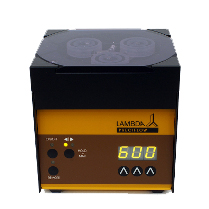 |
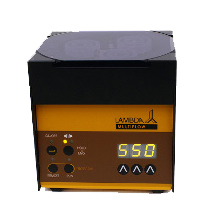 |
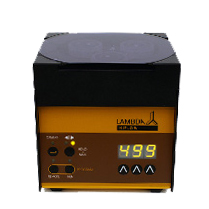 |
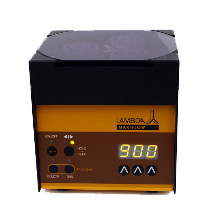 |
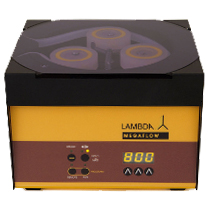 |
Eine LAMBDA PRECIFLOW Schlauchpumpe macht sich schon nach einem Verbrauch von 80 m Schlauch ausbezahlt!
Programmierung: bis zu 99 Schritte aus Geschwindigkeit und Zeit
Zeitauflösung: 0 bis 999 Minuten in 1-Minuten-Schritten oder wahlweise 0 bis 99.9 min in 0.1 Minuten Schritten
Genauigkeit: ± 1%
Wiederholbarkeit: ± 0.2 % (Elektronik)
Durchsatzbereich:
PRECIFLOW & MULTIFLOW: 0.2 µl/min - 600 ml/h
HiFLOW: 1 µl/min - 3’000 ml/h
MAXIFLOW: 3 µl/min - 10’000 ml/h
MEGAFLOW: 0.02 ml/min - 60 l/h
Schlauch: Silikonschläuche mit unterschiedlichen Durchmessern (andere Schläuche mit gleicher Elastizität)
Nichtflüchtiger Speicher: Speicherung aller Einstellungen
Maximaler Druck:
PRECIFLOW, MULTIFLOW, HiFLOW & MAXIFLOW: ca. 0.1 MPa (1 bar) im Uhrzeigersinn drehend; ca. 0.15 MPa (1.5 bar) im Gegenuhrzeigersinn drehend
MEGAFLOW: ca. 0.18 MPa im Uhrzeigersinn drehend; ca. 0.2 MPa im Gegenuhrzeigersinn drehend
Antrieb:
PRECIFLOW & MULTIFLOW: Mikroprozessorgesteuerter Schrittmotor
HiFLOW, MAXIFLOW & MEGAFLOW: bürstenloser langlebiger BLDC-Motor mit Neodym-Magneten
Geschwindigkeitsbereich: 0 - 999
Schnittstelle: RS-485 oder RS-232 (Option)
Fernsteuerung: 0-10 V; (Option 0-20 mA oder 4-20 mA); Fussschalter; Ein/Aus; Aus Sicherheitsgründen darf die Spannung des Fernsignals 48 V DC gegenüber Erde nicht überschreiten.
Abmessungen: 10.5 (B) × 9.5 (H) × 10.5 (T) cm [PRECIFLOW, MULTIFLOW, HiFLOW & MAXIFLOW]; 18 (B) x 13 (H) x 16 (T) cm [MEGAFLOW]
Gewicht: < 1 kg [PRECIFLOW & MULTIFLOW]; 1.2 kg [HiFLOW & MAXIFLOW]; 2.5 kg [MEGAFLOW]
Sicherheit: CE, erfüllt die IEC 1010/1 Norm für Laborgerät
Betriebstemperatur: 0 – 40 ⁰C
Betriebsfeuchtigkeit: 0 - 90 % Relative Luftfeuchtigkeit, nicht kondensierend
- EN - LAMBDA Laboratory Peristaltic Pumps LEAFLET (pdf)
- EN - (Old Operation Manual - LAMBDA PRECIFLOW peristaltic liquid pump – tubing pump) (pdf)
- EN - (Old Operation Manual - LAMBDA HIFLOW laboratory peristaltic pump – tubing pump) (pdf)
- EN - (Old Operation Manual - LAMBDA MULTIFLOW peristaltic dosing pump – tubing pump) (pdf)
- EN - (Old Operation Manual - LAMBDA MAXIFLOW peristaltic pump – tubing pump) (pdf)
- EN - (Old Operation Manual - LAMBDA MEGAFLOW peristaltic pump – tubing pump) (pdf)
- EN - Infographics: LAMBDA laboratory peristaltic pumps make your work simple and easy (pdf)
- EN - Utilization of peristaltic pumps (pdf)
- EN - User manual - LAMBDA laboratory peristaltic pumps (pdf)
- DE - Broschüre LAMBDA Schlauchpumpen für das Labor (pdf)
- DE - Bedienungsanleitung - LAMBDA Schlauchpumpen (pdf)
- DE - (Alte Bedienungsanleitung - PRECIFLOW Schlauchpumpe - Peristaltikpumpe) (pdf)
- DE - (Alte Bedienungsanleitung - MULTIFLOW Schlauchpumpe - Peristaltikpumpe) (pdf)
- DE - (Alte Betriebsanleitung - MAXIFLOW Schlauchquetschpumpe - Peristaltikpumpe) (pdf)
- DE - (Alte Betriebsanleitung - HIFLOW Schlauchquetschpumpe - Peristaltikpumpe) (pdf)
- DE - Vielfältige Anwendungsmöglichkeiten der peristaltischen Pumpen (pdf)
- IT - Manuale operativo - Pompa peristaltica LAMBDA PRECIFLOW (pdf)
- IT - Manuale operativo - Pompa peristaltica LAMBDA HIFLOW (pdf)
- IT - Manuale operativo - Pompa peristaltica LAMBDA MULTIFLOW (pdf)
- IT - Manuale operativo - Pompa peristaltica LAMBDA MAXIFLOW (pdf)
- FR - (Ancien mode d'emploi - Pompe péristaltique PRECIFLOW) (pdf)
- FR - Mode d'emploi - Pompes Péristaltiques LAMBDA (pdf)
- FR - POMPES PÉRISTALTIQUES PRECIFLOW-MULTIFLOW-HiFLOW-MAXIFLOW - BROCHURE (pdf)
- FR - Utilisation des pompes péristaltiques (pdf)
- FR - (Ancien mode d'emploi - Pompe péristaltique HIFLOW) (pdf)
- FR - (Ancien mode d'emploi - Pompe péristaltique MAXIFLOW) (pdf)
- FR - (Ancien mode d'emploi - Pompe péristaltique MULTIFLOW) (pdf)
- CZ - Návod k použití - Peristaltická pumpa LAMBDA MAXIFLOW (pdf)
- CZ - Návod k použití - Peristaltická pumpa LAMBDA PRECIFLOW (pdf)
- CZ - Návod k použití - Peristaltická pumpa LAMBDA MULTIFLOW (pdf)
- CZ - LAMBDA peristalticke pumpy letak (pdf)
- ES - Instrucciones de operación - MULTIFLOW - bomba peristáltica - bomba de tubería (pdf)
- ES - BOMBAS PERISTÁLTICAS PRECIFLOW-MULTIFLOW-HiFLOW-MAXIFLOW-MEGAFLOW - FOLLETO (pdf)
- ES - Usos de las bombas peristalticas (pdf)
- ES - Instrucciones de operación - HIFLOW - bomba peristáltica - bomba de tubería (pdf)
- ES - Instrucciones de operación - PRECIFLOW - bomba peristáltica - bomba de tubería (pdf)
- ES - Instrucciones de operación - MAXIFLOW - bomba peristáltica - bomba de tubería (pdf)
- RU - ПЕРИСТАЛЬТИЧЕСКИЕ НАСОСЫ LAMBDA - PRECIFLOW – MULTIFLOW – HIFLOW – MAXIFLOW - MEGAFLOW - ЛИСТОВКА (pdf)
2024:
Die viskose Aufschlämmung (43.38 g Nasskieselsäure, gemischt mit 170 g Hydrobrite Öl als Lösungsmittel) wurde durch eine LAMBDA Schlauchpumpe in den Reaktor gegeben.
Luo, L., Rix, F. C., Stevens, K. A., Kuo, C. L., Zhang, X., Lovell, J. A., Harlan, C.J., Ye, X., & Berg, B. R. (2024). Improved In-Situ MAO Derived Silica Supported Single-Site Metallocene Catalysts. U.S. Patent Application No. 18/253,867.
https://patents.google.com/patent/US20240092947A1/en (2024 Juni 17)
Kontinuierlicher Bioreaktorbetrieb: Das Reaktionsvolumen wurde mithilfe eines Tauchrohrs und LAMBDA PRECIFLOW Schlauchpumpen auf einem konstanten Niveau gehalten.
Zwerger, P. (2024). Acetic Acid Bioproduction by Acetobacterium woodii in Formate Medium in Continuous Bioreactors (Doctoral dissertation, Technische Universität Wien).
https://doi.org/10.34726/hss.2024.114566
Entwicklung und Optimierung von Rückfaltungsprozessen für Einschlusskörper (inclusion body, IB): Mit einer peristaltischen Pumpe LAMBDA PRECIFLOW wurde solubilisiertes Protein kontinuierlich in den Rückfaltungspuffer dosiert (0.8 L 150 mM Phosphatpuffer, 1 mM EDTA, 20 μM NAD, pH 6.0).
Igwe, C. L., Pauk, J. N., Hartmann, T., & Herwig, C. (2024). Quantitative analytics for protein refolding states. Process Biochemistry, 136, 191-201.
https://doi.org/10.1016/j.procbio.2023.11.022
Fed-Batch Verdünnung: Die LAMBDA PRECIFLOW Schlauchpumpe förderte das solubilisierte Protein mit einer konstanten Zufuhrrate (Prozess P1 = 5.26 ml/h, P2 = 5.61 ml/h, P3 = 6.51 ml/h) in den 3.6 L Labfors 5 Rührtankreaktor (0.8 L Rückfaltungspuffer).
Pauk, J. N., Igwe, C. L., Herwig, C., & Kager, J. (2024). An all-in-one state-observer for protein refolding reactions using particle filters and
delayed measurements. Chemical Engineering Science, 119774.
https://doi.org/10.1016/j.ces.2024.119774
2023:
LAMBDA Peristaltikpumpen für Flüssigkulturmedium (30 ml/h) in einem dynamischen In-vitro-Biofilmmodell unter anaeroben Bedingungen
Alonso-Español, A., Bravo, E., Ribeiro-Vidal, H., Virto, L., Herrera, D., Alonso, B. & Sanz, M. (2023). The Antimicrobial Activity of Curcumin and Xanthohumol on Bacterial Biofilms Developed over Dental Implant Surfaces. Int. J. Mol. Sci. 2023, 24, 2335.
https://doi.org/10.3390/ijms24032335
Zugabe von 2M NaOH mit einer LAMBDA PRECIFLOW Peristaltikpumpe für die pH-Einstellung während der Synthese
Dib, M. A., Gore, E. & Grisel, M. (2023). Intrinsic and rheological properties of hydrophobically modified xanthan synthesized under green conditions. Food Hydrocolloids, Volume 138, 2023, 108461, ISSN 0268-005X.
https://doi.org/10.1016/j.foodhyd.2023.108461
Einfluss von Tensiden auf den vertikalen Transport von Chlorthalonil-Metaboliten (Fungizidmetaboliten) in Erden: 1 ml/min OH-CTL Lösung (40 μg/ml in Wasser, 4 ml) auf Säulen mit Erden und anschliessende Auswaschung mit 1 ml/min Reinstwasser kontinuierlich gepumpt mit einer LAMBDA PRECIFLOW Peristaltikpumpe.
Báez, M.E., Sarkar, B., Peña,A. Vidal, J., Espinoza, J. & Fuentes, E. (2023). Effect of surfactants on the sorption-desorption, degradation, and transport of chlorothalonil and hydroxy-chlorothalonil in agricultural soils. Environmental Pollution, 2023, 121545, ISSN 0269-7491,
https://doi.org/10.1016/j.envpol.2023.121545
Enzymrückfaltung: Zugabe von Cofaktor Hämin (24 ml, 10 h) mit einer LAMBDA PRECIFLOW Pumpe in Kombination mit einer Sartorius Entris Waage und dem PID Regler (Lucullus) mit Störgrössenaufschaltung.
Humer, D., & Ebner, J. (2023). The Purification of Heme Peroxidases from Escherichia coli Inclusion Bodies: A Success Story Shown by the Example of Horseradish Peroxidase. In: Kopp, J., Spadiut, O. (eds) Inclusion Bodies. Methods in Molecular Biology, vol 2617. Humana, New York, NY.
https://doi.org/10.1007/978-1-0716-2930-7_16
LAMBDA PRECIFLOW Schlauchpumpen: Automatische pH-Wert Einstellung (pH 6.5) durch Zugabe von 20 % NaOH (w/v) und 1 N HCl (v/v) während der Batch-Fermentation (Bacillus licheniformis, 2 Liter Arbeitsvolumen) im Laborfermenter LAMBDA MINIFOR 7L .
Dumitru, M. & Ciurescu, G. (2023). Optimization of the fermentation conditions and survival of Bacillus licheniformis as freeze-dried powder for animal probiotic applications. Scientific Papers. Series D. Animal Science. Vol. LXVI, No. 2, 2023; ISSN 2285-5750; ISSN CD-ROM 2285-5769; ISSN Online 2393-2260; ISSN-L 2285-5750.
https://www.animalsciencejournal.usamv.ro/pdf/2023/issue_2/Art10.pdf (2024 Jan. 02)
2022:
LAMBDA Schlauchpumpen im 140-tägigen Dauereinsatz als Medienpumpen für die biotechnologische Capronatsynthese im Chemostaten
Brodowski, F., Lezyk, M., Gutowska & Oleskowicz-Popiel, P. (2022). Effect of external acetate on lactate-based carboxylate platform: Shifted lactate overloading limit and hydrogen co-production. Science of The Total Environment, Volume 802, 2022, 149885, ISSN 0048-9697.
https://doi.org/10.1016/j.scitotenv.2021.149885
Proteinrückfaltung mittels Fed-Batch: Solubilisiertes Protein (LDH in Puffer) wurde in drei Experimenten mit konstanten Zufuhrraten (5.26 ml/h; 5.61 ml/h; 6.51 ml/h) mit einer LAMBDA PRECIFLOW Schlauchpumpe in einen 3.6 L Rührkesselreaktor (0.8 Liter Anfangsvolumen) dosiert.
Pauk, J. N.; Igwe, Ch. L; Herwig, Ch. & all (2023). Full-state monitoring of protein refolding reactions using particle filters and delayed measurements. Authorea. August 19, 2023.
https://doi.org/10.22541/au.169246444.43625502/v1
Eine LAMBDA PRECIFLOW pumpt die Zellsuspension kontinuierlich als Kreislauf zwischen einem Membranmodul (um Zellen abzutrennen und das Fliessgleichgewicht aufrechtzuerhalten) und einem kontinuierlichen Bioreaktor.
Mainka, T., Herwig, C. & Pflügl, S. (2022). Optimized Operating Conditions for a Biological Treatment Process of Industrial Residual Process Brine Using a Halophilic Mixed Culture. Fermentation, 8(6), 246.
https://doi.org/10.3390/fermentation8060246
pH-Stat: Während der Xanthansuccinylierung wurde der pH-Wert (8.3, 8.5, ..., 9.0) durch ein automatisiertes Steuersystem aufrechterhalten, das aus einem M300 Prozesstransmitter (Mettler Toledo), einer pH-Sonde (digital ISM pH/ORP sensor InPro 3253i/SG/225, Mettler Toledo) und einer LAMBDA PRECILFOW Peristaltikpumpe (LAMBDA Laboratory Instruments) für die Zugabe von 2 M NaOH bestand.
Abou Dib, M., Hucher, N., Gore, E. & Grisel, M. (2022). Original tools for xanthan hydrophobization in green media: Synthesis and characterization of surface activity. Carbohydrate Polymers, 291, 119548.
https://doi.org/10.1016/j.carbpol.2022.119548
Abou Dib, M. (2022). Synthèse et caractérisation des propriétés de dérivés amphiphiles de xanthane obtenus par voie verte de greffage. Chimie organique. Normandie Université, 2022. Français. NNT: 2022NORMLH24. tel-04240491 (Doctoral dissertation, Normandie Université).
https://theses.hal.science/tel-04240491/ (30. November 2023)
Kultivierung in kontinuierlichen Bioreaktoren mit einem Arbeitsvolumen von 650 ml / 1000 ml: LAMBDA PRECIFLOW pumpte kontinuierlich das Feed-Medium und eine 1:100 Antischaumlösung (Polypropylenglycol P2000, Sigma-Aldrich) mit einer Verdünnungsrate von 0.05 h−1 bzw. 0.014 min−1.
Vees, C. A., Herwig, C. & Pflügl, S. (2022). Mixotrophic co-utilization of glucose and carbon monoxide boosts ethanol and butanol productivity of continuous Clostridium carboxidivorans cultures. Bioresource Technology, 353, 127138.
https://doi.org/10.1016/j.biortech.2022.127138
Während der Chemostat-Kultivierung wurde eine LAMBDA PRECIFLOW Schlauchpumpe zur Durchflussregulierung von 50 ml/h verwendet.
Zejnilovic, E. (2022). Optimization of process performance and mixotrophic cultivation of Clostridium carboxidivorans for the production of biofuel alcohols. (Doctoral dissertation, TU Vienna).
Die Feed-Durchflussraten von 18 ml/h (Start des Fed-Batchs) bis 125 ml/h (Ende des Fed-Batch) wurden mit einer LAMBDA PRECIFLOW Peristaltikpumpe eingestellt.
Gundinger, T., Kittler, S., Kubicek, S., Kopp, J., & Spadiut, O. (2022). Recombinant protein production in E. coli using the phoA expression system. Fermentation, 8(4), 181.
https://doi.org/10.3390/fermentation8040181
Das Arbeitsmedium wurde mit einer Schlauchpumpe LAMBDA PRECIFLOW mit einer Durchflussrate von 360 ml/h durch das System gepumpt..
Eriksen, A. B. (2023). An Experimental and Numerical Study of the Performance of Carbon Black Nanofluids in a Direct Absorption Solar Collector. (Master's thesis, The University of Bergen).
https://bora.uib.no/bora-xmlui/bitstream/handle/11250/3073833/AgatheBjelland_MasterThesis.pdf (2023 Nov. 28)
Keywords: nanofluid, direct absorption solar collectors, solar energy
LAMBDA MULTIFLOW wurde als externe Pumpe des 2 Liter Fermenters für die Feed-Lösung (600 g/L Glukose, 45 g/L KH2PO4, 24 g/L MgSO4, 30 g/L (NH4)2SO4, 1.2 g/L CaCl2 und 150 ml/L Spurenetalllösung) verwendet.
Wang, G., Tavares, A., Schmitz, S., França, L., Almeida, H., Cavalheiro, J., Carolas, A., Cavalheiro, J., Ozmerih, S., Blank, L.M., Ferreira, B.S. & Borodina, I. (2022). An integrated yeast‐based process for cis, cis‐muconic acid production. Biotechnology and Bioengineering, 119(2), 376-387.
https://doi.org/10.1002/bit.27992
Studien mit Festbettsäulen: Die Glassäule (Füllhöhe mit Kugeln = 5 cm, ID = 1.45 cm) war am oberen Ende mit einer LAMBDA HiFLOW Schlauchpumpe verbunden, um eine konstante Flussrate (1 ml/min) der fünfkomponentigen Schwermetallionenlösungen (HMI) sicherzustellen, die Zn2+, Pb2+, Cd2+, Ni2+ und Co2+ enthalten.
Dinu, M. V., Humelnicu, I., Ghiorghita, C. A., & Humelnicu, D. (2022). Aminopolycarboxylic acids-functionalized chitosan-based composite cryogels as valuable heavy metal ions sorbents: Fixed-bed column studies and theoretical analysis. Gels, 8(4), 221.
https://doi.org/10.3390/gels8040221
Die Laboranlage bestand aus einer Schlauchpumpe LAMBDA MULTIFLOW und einer vertikalen dynamischen Festbettadsorptions-PTFE-Säule (Innendurchmesser 0.6 cm, Höhe 12.3 cm) verbunden mit einem automatischen Probenahmesystem.
Kakamouka, K., Gavriel, C., Salonikidou, E.D., Giannakoudakis, D.A., Kostoglou, M., Triantafyllidis, K.S. & Deliyanni, E.A. (2022). Dynamic/column tests for dibenzothiophene (DBT) removal using chemically functionalized carbons: Investigation of the influence of physicochemical properties and breakthrough modeling. Colloids and Surfaces A: Physicochemical and Engineering Aspects, Volume 642, 2022, 128597, ISSN 0927-7757,
https://doi.org/10.1016/j.colsurfa.2022.128597
Der Bodenmonolith wurde über einen mit einem Wasserreservoir und einer LAMBDA MAXIFLOW Schlauchpumpe verbundenen kapillaren Niederschlagssimulator mit Wasser versorgt.
Ehrhardt, A., Berger, K., Filipovic, V., Wöhling, T., Vogel, H. J. & Gerke, H.H. (2022). Tracing lateral subsurface flow in layered soils by undisturbed monolith sampling, targeted laboratory experiments, and model‐based analysis. Vadose Zone Journal, 21(4), e20206.
https://doi.org/10.1002/vzj2.20206
2021:
Grundlage für die präklinische Studie: LAMBDA MEGAFLOW Pumpe im Versuchsaufbau für die automatische Blutprobenahme aus einem vorhandenen peripheren Katheter und Probenvorbereitung mit Plasmafiltration durch eine Siliziummembran.
Bortolussi, C., Gupta, S., & Schär, B. (2021). Bewertung der automatischen Blutentnahme, inklusive Probenaufbereitung. Securecell AG/ETH Wyss Zurich: Liver4Life group.
https://www.securecell.ch/de/insights/seraccess-milestone-5 (2024 July 16)
LAMBDA MULTIFLOW pumpt einen Mantelstrom, um den Probenstrom in einen zentralen Kern zu leiten, sodass die Partikel den gleichmässig beleuchteten Bereich des DFLS-Systems passieren können.
Xiao, D., Zang, Z., Sapermsap, N., Wang, Q., Xie, W., Chen, Y. & Li, D.D.U. (2021). Dynamic fluorescence lifetime sensing with CMOS single-photon avalanche diode arrays and deep learning processors. Biomed. Opt. Express 12, 3450-3462 (2021);
https://doi.org/10.1364/BOE.425663
Versuchsaufbau im kontinuierlichen Festbettkatalysatorsystem: Durch die untere Öffnung der Säule wurde der phenolhaltige Flüssigkeitsstrom mit der LAMBDA PRECIFLOW Peristaltikpumpe eingeleitet.
Ferreiro Santiso, C., De Luis Álvarez, A. M., Villota Salazar, N., Lomas Esteban, J. M., Lombraña Alonso, J. I., & Camarero Estela, L. M. (2021). Application of a Combined Adsorption− Ozonation Process for Phenolic Wastewater Treatment in a Continuous Fixed-Bed Reactor.
https://doi.org/10.3390/catal11081014
2020:
Vollautomatisch mit Lucullus PIMS Software: Förderpumpen von LAMBDA Laboratory Instruments integriert in Reaktorsysteme für mikrobielle Prozesse mit umfassender Online-Analytik
Kroll, P., Kager, P., & Herwig, C. (2020) Bioprocess Information Management with Lucullus® PIMS for Biochemical Engineering at TU Wien. Securecell Application note #006/April 2020.
https://26638772.fs1.hubspotusercontent-eu1.net/hubfs/26638772/Insights/Lucullus/Bioprocess%20Information%20Management%20with%20Lucullus.pdf (2024 July 17)
Die Fünf-Komponenten-Lösung (Cu2+, Zn2+, Ni2+, Fe3+ and Cr3+ Metallionen) im dynamischen Sorptionsverfahren: Für einen kontinuierlichen Fluss von 1.33 ml/min wurde eine LAMBDA HiFLOW Peristaltikpumpe oben an der kleinen Glassäule (Innendurchmesser 5 cm, Länge 16 cm, Höhe des aufgequollenen Monolithen 2.5 cm) angeschlossen.
Humelnicu, D., Dragan, E. S., Ignat, M., & Dinu, M. V. (2020). A comparative study on Cu2+, Zn2+, Ni2+, Fe3+, and Cr3+ metal ions removal from industrial wastewaters by chitosan-based composite cryogels. Molecules, 25(11), 2664.
https://doi.org/10.3390/molecules25112664
Verschlussbildung im 3D-gedruckten Modell der mittleren Hirnarterie (MCA): Das MCA-Modell wurde an einen LAMBDA MULTIFLOW angeschlossen, der Schlauch (Innendurchmesser 3.1 mm) wurde mit TBS-Puffer (pH 7.4) gefüllt und der Thrombus in den Schlauch eingeführt; Nach der Bildung des MCA-Verschlusses betrug die Flussrate durch einen Arterienzweig 4.5 ml/min.
Vítečková Wünschová, A., Novobilský, A., Hložková, J., Scheer, P., Petroková, H., Jiřík, R., Kulich, P., Bartheldyová, E., Hubatka, F., Jonas, V., Mikulík, R., Malý, P. & Mašek, J. (2020). Thrombus imaging using 3D printed middle cerebral artery model and preclinical imaging techniques: Application to thrombus targeting and thrombolytic studies. Pharmaceutics, 12(12), 1207.
https://doi.org/10.3390/pharmaceutics12121207
Proben (5 ml) wurden in einem Suspensionsexperiment mit der Schlauchpumpe LAMBDA PRECIFLOW durch eine poröse PES-Hohlfaser extrahiert.
Schroeder, H., Duester, L., Fabricius, A. L., Ecker, D., Breitung, V., & Ternes, T. A. (2020). Sediment water (interface) mobility of metal (loid) s and nutrients under undisturbed conditions and during resuspension. Journal of hazardous materials, 394, 122543.
https://doi.org/10.1016/j.jhazmat.2020.122543
Für die Produktion von rekombinantem Cytochrom in einem Bioreaktor wurde der Feed mit einer vom Prozessinformationsmanagementsystem gesteuerten LAMBDA PRECIFLOW Peristaltikpumpe gepumpt und die Zugabe gravimetrisch überwacht.
Hausjell, J., Schendl, D., Weissensteiner, J., Molitor, C., Halbwirth, H., & Spadiut, O. (2020). Recombinant production of a hard‐to‐express membrane‐bound cytochrome P450 in different yeasts—Comparison of physiology and productivity. Yeast, 37(2), 217-226.
https://doi.org/10.1002/yea.3441
2019:
LAMBDA MULTIFLOW pumpte das Medium kontinuierlich mit einem Durchfluss von 5.1 ml/min durch die Durchflusszelle.
Čapková-Helešicová, T., Pekárek, T., Schöngut, M., & Matějka, P. (2019). New designed special cells for Raman mapping of the disintegration process of pharmaceutical tablets. Journal of Pharmaceutical and Biomedical Analysis, 168, 113-123.
https://doi.org/10.1016/j.jpba.2019.02.019
LAMBDA PRECIFLOW als gesteuerte Fütterungspumpe für den exponentiellen Feed in der Fedbatch-Fermentation (Escherichia coli, 5 – 8 Liter Arbeitsvolumen) während der Wachstumsphase (14 h, μ = 0.1 h−1) und der induzierten Proteinproduktion (μ = 0.04 h−1)
Quehenberger, J., Reichenbach, T., Baumann, N., Rettenbacher, L., Divne, C. & Spadiut, O. (2019). Kinetics and Predicted Structure of a Novel Xylose Reductase from Chaetomium thermophilum. Int. J. Mol. Sci. 2019, 20, 185.
https://doi.org/10.3390/ijms20010185
LAMBDA Peristaltikpumpen wurden mit Bioreaktoren von Drittanbietern zum präzisen Pumpen von Flüssigkeiten verwendet.
Hofer, A., Kroll, P. & Herwig, C. (2019). Automated sampling and on-line analytics to increase process understanding. Securecell AG, In der Luberzen 29, CH-8902 Urdorf, Switzerland and TU Wien, Gumpendorfer Strasse 1a, A-1060 Wien, Austria.
https://doi.org/10.13140/RG.2.2.30419.63523
Die Schlauchpumpe LAMBDA PRECIFLOW erfüllt die Anforderungen zur Substratzufuhr in Schüttelkolben: Die Pumpe erlaubt Fördermengen zwischen 0.01 und 60 ml/h.
Wagner, S. G., Mähler, C., Polte, I., von Poschinger, J., Löwe, H., Kremling, A., & Pflüger-Grau, K. (2019). An automated and parallelised DIY-dosing unit for individual and complex feeding profiles: Construction, validation and applications. PloS one, 14(6), e0217268.
https://doi.org/10.1371/journal.pone.0217268
Acht Proben der Lösung wurden minütlich in einer neuen Petrischale gesammelt. Zur Schaffung eines Strömungssystems wurde eine LAMBDA PRECIFLOW Peristaltikpumpe in Kombination mit einem transparenten Silikonschlauch (Innen-⌀ = 3 mm) verwendet.
Steendam, R. R., & Frawley, P. J. (2019). Secondary nucleation of sodium chlorate: the role of initial breeding. Crystal Growth & Design, 19(6), 3453-3460.
https://doi.org/10.1021/acs.cgd.9b00317
2018:
Mit der zentrifugenlosen dispersiven Flüssig-Flüssig-Mikroextraktion wurden verbotener Sudanfarbstoffe aus Lebensmittel- und Wasserproben effizient extrahiert: Für die Phasentrennung wurde eine LAMBDA MULTIFLOW Peristaltikpumpe eingesetzt.
Bazregar, M., Rajabi, M., Yamini, Y., Arghavani-Beydokhti, S., & Asghari, A. (2018). Centrifugeless dispersive liquid-liquid microextraction based on salting-out phenomenon followed by high performance liquid chromatography for determination of Sudan dyes in different species. Food chemistry, 244, 1-6.
https://doi.org/10.1016/j.foodchem.2017.10.006
Der beste geschlossene Reaktor wurde ausgewählt und die Betriebsparameter für Fluss und Kontaktzeit für zwei Zyklen optimiert, wobei der Fluss durch die LAMBDA MULTIFLOW Peristaltikpumpe gesteuert wurde.
de Llasera, M. G., Santiago, M. L., Flores, E. L., Toris, D. B., & Herrera, M. C. (2018). Mini-bioreactors with immobilized microalgae for the removal of benzo (a) anthracene and benzo (a) pyrene from water. Ecological Engineering, 121, 89-98.
https://doi.org/10.1016/j.ecoleng.2017.06.059
Zufuhr-, Schleifen-, Bleed- und Ernteschlauchpumpen LAMBDA PRECIFLOW für die kontinuierliche Kultivierung extremer Halophile in massgeschneiderten Bioreaktoren im Pilotmassstab
Mahler, N., Tschirren, S., Pflügl, S., & Herwig, C. (2018). Optimized bioreactor setup for scale-up studies of extreme halophilic cultures. Biochemical Engineering Journal, 130, 39-46.
https://doi.org/10.1016/j.bej.2017.11.006
2016:
Turbidostat bestehend aus zwei LAMBDA PRECIFLOW Peristaltikpumpen mit RS-232-Schnittstelle zur automatisierten optogenetischen Regulierung der Proteinproduktion in flüssigen Escherichia coli Kulturen
Milias-Argeitis, A., Rullan, M., Aoki, S. K., Buchmann, P., & Khammash, M. (2016). Automated optogenetic feedback control for precise and robust regulation of gene expression and cell growth. Nature communications, 7(1), 12546.
https://doi.org/10.1038/ncomms12546
Adaptive Zuführstrategie mit durch Echtzeitsignale (Lucullus) gesteuerter Zufuhrrate der LAMBDA PRECIFLOW Pumpe im Fed-Batch-Verfahren
Konakovsky, V., Clemens, C., Müller, M. M., Bechmann, J., Berger, M., Schlatter, S., & Herwig, C. (2016). Metabolic control in mammalian fed-batch cell cultures for reduced lactic acid accumulation and improved process robustness. Bioengineering, 3(1), 5.
https://doi.org/10.3390/bioengineering3010005
2015:
Die peristaltische Pumpe LAMBDA MULTIFLOW wurde verwendet, um die Extraktion von Blei(II), Chrom(III) und Kupfer(II) an einem neuartigen Adsorbens zu bewerten
Barfi, B., Rajabi, M., Zadeh, M. M., Ghaedi, M., Salavati-Niasari, M., & Sahraei, R. (2015). Extraction of ultra-traces of lead, chromium and copper using ruthenium nanoparticles loaded on activated carbon and modified with N, N-bis-(α-methylsalicylidene)-2, 2-dimethylpropane-1, 3-diamine. Microchimica Acta, 182, 1187-1196.
https://doi.org/10.1007/s00604-014-1434-z
2014:
Digitale LAMBDA PRECIFLOW Peristaltikpumpen wurden als Förderpumpe, Bleed-Pumpe und zellfreie Erntepumpe verwendet, um die Produktivität extrem halophiler Archäonen in einem Bioreaktor zu maximieren, der mit einem externen Zellretentionssystem ausgestattet ist.
Lorantfy, B., Ruschitzka, P., & Herwig, C. (2014). Investigation of physiological limits and conditions for robust bioprocessing of an extreme halophilic archaeon using external cell retention system. Biochemical engineering journal, 90, 140-148.
https://doi.org/10.1016/j.bej.2014.06.004
Für DoE-Experimente wurde 1.0 mol/L (NH4)2CO3 als Stickstoffquelle verwendet und der Zufluss wurde gravimetrisch bei festgelegten Pumpensollwerten durch die LAMBDA PRECIFLOW Schlauchpumpe gesteuert.
Bernacchi, S., Rittmann, S., Seifert, A. H., Krajete, A., & Herwig, C. (2014). Experimental methods for screening parameters influencing the growth to product yield (Y (x/CH4)) of a biological methane production (BMP) process performed with Methanothermobacter marburgensis. AIMS Bioengineering, 1(2), 72-87.
https://doi.org/10.3934/bioeng.2014.2.72
Der Durchsatz des Feeds wurde durch die Steuerung der Geschwindigkeit der Laborschlauchpumpe LAMBDA PRECIFLOW in der kontinuierlichen Kultur von Methanothermobacter marburgensis konstant gehalten.
Seifert, A. H., Rittmann, S., & Herwig, C. (2014). Analysis of process related factors to increase volumetric productivity and quality of biomethane with Methanothermobacter marburgensis. Applied Energy, 132, 155-162.
https://doi.org/10.1016/j.apenergy.2014.07.002
Die Schlauchpumpe LAMBDA MULTIFLOW und eine Säule aus Polytetrafluorethylen (PTFE, 25 mm x 7.0 mm Innendurchmesser) wurden verwendet, um die Eignung hybrider SiO2/TiO2-NH2-Nanopartikel für die Festphasenextraktion von Blei, Kupfer und Zink aus verschiedenen Lebensmitteln und Wasser zu untersuchen Proben.
Rajabi, M., Barfi, B., Asghari, A., Najafi, F., & Aran, R. (2015). Hybrid amine-functionalized titania/silica nanoparticles for solid-phase extraction of lead, copper, and zinc from food and water samples: kinetics and equilibrium studies. Food Analytical Methods, 8, 815-824.
https://doi.org/10.1007/s12161-014-9964-x
LAMBDA MULTIFLOW Peristaltikpumpe zur Untersuchung des Einflusses der Eluentenflussrate (1.0 - 6.0 ml/min) bei der hochselektiven Festphasenextraktion
Rajabi, M., Mohammadi, B., Asghari, A., Barfi, B., & Behzad, M. (2014). Nano-alumina coated with SDS and modified with salicylaldehyde-5-sulfonate for extraction of heavy metals and their determination by anodic stripping voltammetry. Journal of industrial and engineering chemistry, 20(5), 3737-3743.
https://doi.org/10.1016/j.jiec.2013.12.073
Das einströmende Medium wurde mit LAMBDA PRECIFLOW Laborschlauchpumpen zu den Säulen gepumpt, die Dehalococcoides zur PCE-Bioremediation enthielten.
Lacroix, E., Brovelli, A., Maillard, J., Rohrbach-Brandt, E., Barry, D. A., & Holliger, C. (2014). Use of silicate minerals for long-term pH control during reductive dechlorination of high tetrachloroethene concentrations in continuous flow-through columns. Science of the Total Environment, 482, 23-35.
https://doi.org/10.1016/j.scitotenv.2014.02.099
2013:
Eine LAMBDA HiFLOW Peristaltikpumpe mit Tygon R-3603 Schlauch pumpte das Porenwasser für die Probenahme unter einem Ar-Strom mit hohem Durchfluss in jeder Kammer an die Oberfläche.
Wang, Y., Frutschi, M., Suvorova, E., Phrommavanh, V., Descostes, M., Osman, A. A. A.,Geipel, G., & Bernier-Latmani, R. (2013). Mobile uranium (IV)-bearing colloids in a mining-impacted wetland. Nature communications, 4(1), 2942.
https://doi.org/10.1038/ncomms3942
LAMBDA MULTIFLOW pumpte das simulierte Abwasser mit gelöstem Farbstoff durch den Reaktor mit immobilisiertem TiO2, um den Abbau von Textilfarbstoffen zu untersuchen.
Sima, J., & Hasal, P. (2013). Photocatalytic degradation of textile dyes in a TiO 2/UV system. Chemical Engineering Transactions, 32, 79-84.
https://doi.org/10.3303/CET1332014
Das Medium wurde dem Bioreaktor kontinuierlich von der LAMBDA PRECIFLOW Förderpumpe mit der gewünschten Verdünnungsrate (D) zugeführt.
Martinez-Porqueras, E., Wechselberger, P., & Herwig, C. (2013). Effect of medium composition on biohydrogen production by the extreme thermophilic bacterium Caldicellulosiruptor saccharolyticus. International journal of hydrogen energy, 38(27), 11756-11764.
https://doi.org/10.1016/j.ijhydene.2013.06.124
Im kontinuierlichen Kulturmodus wurde das Medium für bestimmte Verdünnungsraten (D) durch eine mit kontrollierten Sollwerten betriebene LAMBDA PRECIFLOW Förderpumpe zugeführt.
Martinez-Porqueras, E., Rittmann, S., & Herwig, C. (2013). Analysis of H2 to CO2 yield and physiological key parameters of Enterobacter aerogenes and Caldicellulosiruptor saccharolyticus. International journal of hydrogen energy, 38(25), 10245-10251.
https://doi.org/10.1016/j.ijhydene.2013.06.021
Die Schlauchpumpe LAMBDA PRECIFLOW führte dem Bioreaktor Kulturmedium zu, während die Zufuhrdurchflussrate für die mittlere Verdünnungsrate von 0.05 h-1 durch die Steuerung der Pumpengeschwindigkeit konstant gehalten wurde.
Seifert, A. H., Rittmann, S., Bernacchi, S., & Herwig, C. (2013). Method for assessing the impact of emission gasses on physiology and productivity in biological methanogenesis. Bioresource technology, 136, 747-751.
https://doi.org/10.1016/j.biortech.2013.03.119
2012:
Für die kontinuierliche Kultur von Methanothermobacter marburgensis lieferte die mit Sollwerten angesteuerte LAMBDA PRECIFLOW Pumpe kontinuierlich das Flüssigmedium mit der gewünschten Mediumverdünnungsraten.
Rittmann, S., Seifert, A., & Herwig, C. (2012). Quantitative analysis of media dilution rate effects on Methanothermobacter marburgensis grown in continuous culture on H2 and CO2. Biomass and Bioenergy, 36, 293-301.
https://doi.org/10.1016/j.biombioe.2011.10.038
Sicherstellung der Säulensättigung durch den Aufwärtsfluss mit der LAMBDA MULTIFLOW
May, C. C., Young, L., Worsfold, P. J., Heath, S., Bryan, N. D., & Keith-Roach, M. J. (2012). The effect of EDTA on the groundwater transport of thorium through sand. Water research, 46(15), 4870-488
https://doi.org/10.1016/j.watres.2012.06.012
2011:
Flexibler Polyethylenschlauch wurde für das optimale Algenwachstum in die LAMBDA PRECIFLOW Förderpumpe eingesetzt.
Legendre, A. & Desmazieres, N. (2011). Device for Cultivating Algae and/or Microorganisms for Treating an Effluent and Biological Frontage. United States Patent Application 20110318819.
https://patents.google.com/patent/EP2367926A2 (1. June 2021)
Zur Untersuchung der Anhaftung von Staphylococcus epidermidis induzierte eine LAMBDA Schlauchpumpe den Milchfluss (Flussraten 340 ml/h und 980 ml/h) in eine Teflonkammer mit Edelstahlspänen.
Jaglic, Z., Cervinkova, D., Michu, E., Holasova, M., Roubal, P., Vlkova, H., Babak, V., & Schlegelova, J. (2011). Effect of milk temperature and flow on the adherence of Staphylococcus epidermidis to stainless steel in amounts capable of biofilm formation. Dairy science & technology, 91, 361-372.
https://doi.org/10.1007/s13594-011-0017-6
2010:
Die LAMBDA PRECIFLOW Peristaltikpumpe wird als Förderpumpe für Glycerin während der Fermentation von E. coli und zur Herstellung von Chitinkügelchen verwendet.
Lavallaz, G. D. (2010). Purification de GFP avec et sans marqueur d'affinité (Doctoral dissertation, Haute Ecole d'Ingénierie).
https://doc.rero.ch/record/22518 (03. June 2021)
2009:
Die Probenzugabe mit einer Durchflussrate von 0.5 ml/h in die mit Silica-Mikrokügelchen gefüllte, optisch transparente Silica-Kapillare erfolgte mit einer LAMBDA Schlauchpumpe mit RS-485 Schnittstelle.
Scarmagnani, S., Walsh, Z., Lopez, F. B., Slater, C., Macka, M., Paull, B., & Diamond, D. (2009). Photoswitchable stationary phase based on packed spiropyran functionalized silica microbeads. e-Journal of Surface Science and Nanotechnology, 7, 649-652.
https://doi.org/10.1380/ejssnt.2009.649
2008:
Zwei über PC gesteuerte LAMBDA HiFLOW Peristaltikpumpen zur Gradientenbildung für die Reinigung von menschlichen Inselzellen
Friberg, A. S., Ståhle, M., Brandhorst, H., Korsgren, O., & Brandhorst, D. (2008). Human islet separation utilizing a closed automated purification system. Cell transplantation, 17(12), 1305-1313.
https://doi.org/10.3727/096368908787648100
2007:
Injektion unterschiedlicher Proben mit den Schlauchpumpen LAMBDA MULTIFLOW
Stjernlöf, A. (2007). Portable capillary electrophoresis system with LED-absorbance photometric and LED-induced fluorescence detection. Thesis for the degree in Master of Science, Analytical Chemistry, performed at Dublin City University 2007.
https://kau.diva-portal.org/smash/get/diva2:5248/FULLTEXT01.pdf (2024 Feb. 08)
Programmierbare LAMBDA MULTIFLOW Feedpumpe zur automatischen Regulierung des Sauerstoffverbrauchs und der Temperatur
Vanags, J., Rychtera, M., Ferzik, S., Vishkins, M., & Viesturs, U. (2007). Oxygen and temperature control during the cultivation of microorganisms using substrate feeding. Engineering in Life Sciences, 7(3), 247-252.
https://doi.org/10.1002/elsc.200620184
LAMBDA PRECIFLOW Feed- und Harvestpumpen für die Perfusionskultur tierischer Zellen mit Spinfilter
Vallez-Chetreanu, F., Ferreira, L. F., Rabe, R., von Stockar, U., & Marison, I. W. (2007). An on-line method for the reduction of fouling of spin-filters for animal cell perfusion cultures. Journal of biotechnology, 130(3), 265-273.
https://doi.org/10.1016/j.jbiotec.2007.04.007
2006:
Zur Untersuchung der Retention tierischer Zellen wurden LAMBDA PRECIFLOW Peristaltikpumpen verwendet, um das Medium in den Reaktor einzuspeisen und das Perfusat aus dem Spinfilter zu entnehmen.
Vallez-Chetreanu, F. (2006). Characterization of the mechanism of action of spin-filters for animal cell perfusion cultures. EPFL PhD diss. NO 3488, École Polytechnique Fédérale de Lausanne, Switzerland.
https://doi.org/10.5075/epfl-thesis-3488
2003:
LAMBDA PRECIFLOW als Förderpumpe in Fed-Batch und kontinuierlichen Kulturen zur Aufrechterhaltung der konstanten Verdünnungsraten von Saccharomyces cerevisiae Hefen.
Stark, D., Zala, D., Münch, T., Sonnleitner, B., Marison, I. W., & Von Stockar, U. (2003). Inhibition aspects of the bioconversion of L-phenylalanine to 2-phenylethanol by Saccharomyces cerevisiae. Enzyme and Microbial Technology, 32(2), 212-223.
https://doi.org/10.1016/S0141-0229(02)00237-5
Die LAMBDA PRECIFLOW Fütterungspumpe wurde für die Produktion von 2-Phenylethanol (PEA) durch die In-situ-Produktentfernungsmethode (ISPR) verwendet.
Stark, D., Kornmann, H., Münch, T., Sonnleitner, B., Marison, I. W., & Von Stockar, U. (2003). Novel type of in situ extraction: use of solvent containing microcapsules for the bioconversion of 2‐phenylethanol from L‐phenylalanine by Saccharomyces cerevisiae. Biotechnology and bioengineering, 83(4), 376-385.
https://doi.org/10.1002/bit.10679
1998:
Der pH-Wert 4 wird durch die kontrollierte Zugabe von Säure oder Base mithilfe einer LAMBDA PRECIFLOW Peristaltikpumpe konstant gehalten.
Vicente, A., Castrillo, J. I., Teixeira, J. A., & Ugalde, U. (1998). On‐line estimation of biomass through pH control analysis in aerobic yeast fermentation systems. Biotechnology and bioengineering, 58(4), 445-450.
https://doi.org/10.1002/(SICI)1097-0290(19980520)58:4%3C445::AID-BIT12%3E3.0.CO;2-A
1995:
Die LAMBDA PRECIFLOW Laborschlauchpumpe wurde zur Aufrechterhaltung eines konstanten pH-Werts für die genaue quantitative Bestimmung der Nettoprotonenproduktion oder des Nettoprotonenverbrauchs in Chemostatkulturen von Candida utilis verwendet.
Castrillo, J. I., De Miguel, I., & Ugalde, U. O. (1995). Proton production and consumption pathways in yeast metabolism. A chemostat culture analysis. Yeast, 11(14), 1353-1365.
https://doi.org/10.1002/yea.320111404
1994:
Förderpumpe: Konzentrierte Nährlösungen wurden mit einer LAMBDA Peristaltikpumpe zur Produktion von Erythromycin aus dem Stamm Saccharopolyspora erythraea im Fed-Batch zugeführt.
Potvin, J., & Péringer, P. (1994). Ammonium regulation in Saccharopolyspora erythraea. Part II: Regulatory effects under different nutritional conditions. Biotechnology letters, 16, 69-74.
https://doi.org/10.1007/BF01022626
1993:
Der pH-Wert 3.5 (±0.01) der Molke Chemostat-Kultur wurde mit der Laborschlauchpumpe LAMBDA PRECIFLOW eingestellt.
Castrillo, J. I., & Ugalde, U. O. (1993). Patterns of energy metabolism and growth kinetics of Kluyveromyces marxianus in whey chemostat culture. Applied microbiology and biotechnology, 40, 386-393.
https://doi.org/10.1007/BF00170398
What is the flow range?
Depending on the pump you select, our pumps offer a range of flow rates from 0.2 µl/min to 60,000 ml/hour.
Is the flow reversible?
Yes. The desired flow could achieved either by clock-wise or anticlock-wise rotation.
Could you please provide me information about the precision of dosing of a Lambda peristaltic pump?
Accuracy of the pumps is about ±1% and the reproducibility is ±0.2% (electronics). Speed of rotation of the pump motor is regulated with a precision of quartz watch, which in-turn assures a high precision of the flow rate.
How would I calibrate the flow rate in peristaltic pumps?
The calibration of the pump flow rate with speed can be done to know the amount of the liquid pumped. It could be done in two ways: volumetric calibration of the peristaltic pump flow and pump flow calibration by weight. A short video of peristaltic pump flow calibration can be found at https://www.lambda-instruments.com/peristaltic-pumps/#video
Can I get multi-channel pumps?
We do not manufacture multi-channel pumps. Because with the multi-channel pumps it is not possible to achieve the precise and reproducible flow rates with only one pump motor. For the high precision of flow rate, it is not advisable to use the multi-channel pumps.
If one channel gets blocked then your whole project will get spoiled totally. Instead, we recommend having individual pumps.
Why do I need to use LAMBDA individual pumps over multi-channel pump?
It has more advantages over the multi-channel pumps. The most important thing to take into account is the precise, reproducible and steady flow rate.
If one channel gets blocked then your whole project will get spoiled totally.
The bench space required for the needed channel equivalent to individual LAMBDA Pumps is same as that of a single multi-channel pump, because of the compact structure of the LAMBDA Pumps.
The individual pumps can be used in other projects too.
Do you have pumps on stock?
Yes, we have the pumps in stock. We maintain a large stock of instruments, in order to be able to quickly set them up in the desired configuration and to dispatch them in shortest possible time, within few days!
